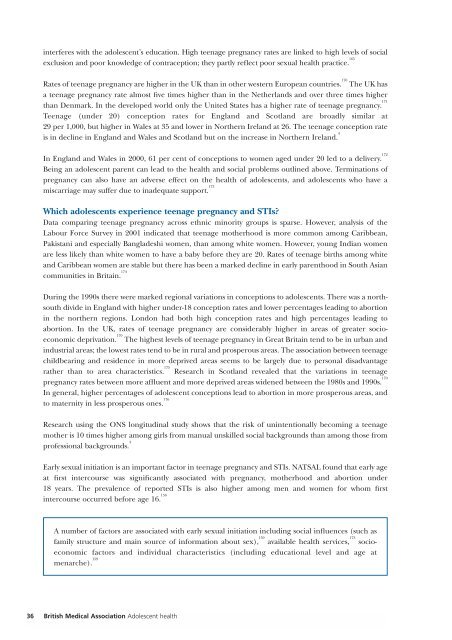Alcohol misuse: tackling the UK epidemic - London
Alcohol misuse: tackling the UK epidemic - London
Alcohol misuse: tackling the UK epidemic - London
You also want an ePaper? Increase the reach of your titles
YUMPU automatically turns print PDFs into web optimized ePapers that Google loves.
36<br />
interferes with <strong>the</strong> adolescent’s education. High teenage pregnancy rates are linked to high levels of social<br />
exclusion and poor knowledge of contraception; <strong>the</strong>y partly reflect poor sexual health practice. 165<br />
Rates of teenage pregnancy are higher in <strong>the</strong> <strong>UK</strong> than in o<strong>the</strong>r western European countries. 170<br />
The <strong>UK</strong> has<br />
a teenage pregnancy rate almost five times higher than in <strong>the</strong> Ne<strong>the</strong>rlands and over three times higher<br />
than Denmark. In <strong>the</strong> developed world only <strong>the</strong> United States has a higher rate of teenage pregnancy. 171<br />
Teenage (under 20) conception rates for England and Scotland are broadly similar at<br />
29 per 1,000, but higher in Wales at 35 and lower in Nor<strong>the</strong>rn Ireland at 26. The teenage conception rate<br />
is in decline in England and Wales and Scotland but on <strong>the</strong> increase in Nor<strong>the</strong>rn Ireland. 4<br />
In England and Wales in 2000, 61 per cent of conceptions to women aged under 20 led to a delivery. 172<br />
Being an adolescent parent can lead to <strong>the</strong> health and social problems outlined above. Terminations of<br />
pregnancy can also have an adverse effect on <strong>the</strong> health of adolescents, and adolescents who have a<br />
miscarriage may suffer due to inadequate support. 173<br />
Which adolescents experience teenage pregnancy and STIs?<br />
Data comparing teenage pregnancy across ethnic minority groups is sparse. However, analysis of <strong>the</strong><br />
Labour Force Survey in 2001 indicated that teenage mo<strong>the</strong>rhood is more common among Caribbean,<br />
Pakistani and especially Bangladeshi women, than among white women. However, young Indian women<br />
are less likely than white women to have a baby before <strong>the</strong>y are 20. Rates of teenage births among white<br />
and Caribbean women are stable but <strong>the</strong>re has been a marked decline in early parenthood in South Asian<br />
communities in Britain. 174<br />
During <strong>the</strong> 1990s <strong>the</strong>re were marked regional variations in conceptions to adolescents. There was a northsouth<br />
divide in England with higher under-18 conception rates and lower percentages leading to abortion<br />
in <strong>the</strong> nor<strong>the</strong>rn regions. <strong>London</strong> had both high conception rates and high percentages leading to<br />
abortion. In <strong>the</strong> <strong>UK</strong>, rates of teenage pregnancy are considerably higher in areas of greater socioeconomic<br />
deprivation. 170<br />
The highest levels of teenage pregnancy in Great Britain tend to be in urban and<br />
industrial areas; <strong>the</strong> lowest rates tend to be in rural and prosperous areas. The association between teenage<br />
childbearing and residence in more deprived areas seems to be largely due to personal disadvantage<br />
ra<strong>the</strong>r than to area characteristics. 175<br />
Research in Scotland revealed that <strong>the</strong> variations in teenage<br />
pregnancy rates between more affluent and more deprived areas widened between <strong>the</strong> 1980s and 1990s. 170<br />
In general, higher percentages of adolescent conceptions lead to abortion in more prosperous areas, and<br />
to maternity in less prosperous ones. 176<br />
Research using <strong>the</strong> ONS longitudinal study shows that <strong>the</strong> risk of unintentionally becoming a teenage<br />
mo<strong>the</strong>r is 10 times higher among girls from manual unskilled social backgrounds than among those from<br />
professional backgrounds. 4<br />
Early sexual initiation is an important factor in teenage pregnancy and STIs. NATSAL found that early age<br />
at first intercourse was significantly associated with pregnancy, mo<strong>the</strong>rhood and abortion under<br />
18 years. The prevalence of reported STIs is also higher among men and women for whom first<br />
intercourse occurred before age 16. 156<br />
A number of factors are associated with early sexual initiation including social influences (such as<br />
family structure and main source of information about sex), 159<br />
available health services, 173<br />
socioeconomic<br />
factors and individual characteristics (including educational level and age at<br />
menarche). 159<br />
British Medical Association Adolescent health
















